Mercedes-Benz Debuts All Kinds of EVs in Munich
Mercedes-Benz used the inaugural edition of the IAA in Munich (formerly held in Frankfurt) to debut several new electric vehicles, some of them in concept form and other as production models.
Let’s take a tour, shall we?
- Also: Mercedes-AMG GT 63 E Performance Unveiled as 831-hp PHEV Sports Sedan
- Also: Mercedes me Charge Debuts as Yet Another EV Charging Platform
Mercedes-AMG EQS 4MATIC+
In a first for the AMG brand, the fully electric Mercedes-AMG EQS 4MATIC+ is a sportier variant of the classy EQS sedan with 658 or 750 horsepower depending on the model (max torque is rated at 750 pound-feet). The AMG-specific electric motors at the front and rear axles take 3.4 seconds to sprint from 0-100 km/h. Quite frankly, we expected the car to be quicker than that.
AMG Performance 4MATIC+ all-wheel drive, AMG RIDE CONTROL+ adaptive air suspension, rear-wheel steering, high-performance brakes, 21- or 22-inch wheels and special AMG sport seats are also part of the mix.

Mercedes-Benz EQE
Slightly smaller than the EQS, the new EQE is a midsize car comparable to the CLS but with interior dimensions that clearly exceed those of the E-Class. It will launch in several markets including Canada, starting with the 288-horsepower EQE 350 4MATIC that features a 90-kWh battery. Other models will follow.
The EQE boasts a more athletic stance and silhouette than the EQS. Riding on distinctive wheels that range from 19-21 inches in size, it is available with AIRMATIC suspension, rear-wheel steering and the wall-to-wall MBUX Hyperscreen.

Mercedes-Benz EQB
Unveiled in a world premiere back in April and offering seating for up to seven, the EQB electric compact SUV will become the third EQ model from Mercedes-Benz to hit the Canadian market next year, following the EQS and EQE.
The EQB 350 4MATIC generates 288 horsepower and provides a range of 419 kilometres based on the WLTP standard used in Europe. The North American-spec model won’t be able to travel that far on a full charge, mind you, which is disappointing. Further details will be released in the coming months.

Mercedes-Benz Concept EQG
A couple of years ago, the German automaker promised to electrify the iconic G-Class. The Concept EQG shown here is a near-production study with signature G-Class styling mixed with Mercedes-Benz EQ design dues, such as a black panel replacing the front grille and LED accents all around. The 22-inch wheels have a pretty cool look, too. Instead of the usual spare wheel cover, there is a lockable box with white illuminated accents on the rear hatch, whose design is reminiscent of a wallbox. This could be used, for example, to store the charging cable within easy reach.
With four electric motors positioned close to the wheels and individually controllable, plus a newly developed suspension, the EQG will offer unique driving characteristics both on and off the road, Mercedes-Benz claims. No performance figures were provided, however.

Mercedes-Maybach Concept EQS
A large SUV built from the EQS sedan is due to enter production next year, after which the company will spawn the ultimate luxury version in the form of the Mercedes-Maybach EQS, as foreshadowed by the concept shown in Munich.
Similar to the Maybach S-Class, the vehicle stands out with a two-tone exterior, while vertical Maybach pinstripes are elegantly integrated to the front black panel. The extremely opulent interior is designed to maximize comfort and relaxation with the First-Class rear suite, High-End Rear Seat Entertainment System, large footrests and more.

Mercedes-Benz VISION AVTR
Remember the mind-boggling VISION AVTR concept unveiled at the 2020 CES in Las Vegas? This week in Munich, the automaker is showing an even more futuristic evolution that gives an outlook on possible applications of brain-computer interface (BCI) technology.
Selecting the navigation destination, switching the ambient light in the interior or changing the radio station using thought control could become a reality at some point—not just science fiction. After a short calibration process, a BCI device attached to the user's head analyzes the measured brain waves and triggers a defined function. Visitors in Munich can experience controlling the user interface in the vehicle with their own thoughts and interacting with it in real time, turning them into BCI believers.

Don’t miss our photo gallery above!
